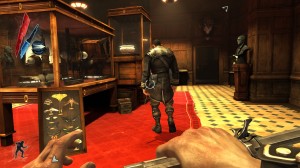I’ve been meaning to play Dishonored for a while now. It was a significant release for me, as it can be seen as a spiritual cousin of Thief and Deus ex, two of the greatest games in PC history. It draws on Thief’s stealth and exploration, and from Ion Storm’s classic it takes the flexible gameplay, giving your character multiple ways to solve problems.
I’m only on about the fifth level so far, so am just putting down some thoughts. The game casts you as Corvo – former devoted bodyguard of the empress of the isles, framed for her murder by traitors. A loyalist movement breaks you out of prison, an encounter with a mysterious being called the Outsider sets you up with magical powers, and you’re all set to take your revenge.
The missions all take place in Dunwall, capital of the isles. It has a Victorian, industrial style to it, embellished with leaps of technology such as lightning-based security systems and stilt-walking powered armour suits, that give it a bit of a steampunk feel. There’s also, behind the scenes, an undercurrent of dark sorcery. The city streets are dank and rat-infested, whilst the wealthy live safe behind their walls and guards, in opulent mansions. Up close it’s ugly and dangerous, but still somehow impressive when you look out across the water, at sunset, at clock towers, factories and red-brick warehouses. So all suitably atmospheric, then. It’s reminiscent of the city from the Thief series, especially the more industrialised version we saw in Thief 2.
Your main goal on each map is to dispose of some key figure in the rebellion – either just kill them, or find some other way to effectively remove them from the city. There are also secondary goals along the way, and also you’re on the lookout for loot – magical powerups and gold with which to buy ammo and upgrades. So there is a bit of thieving on offer here alongside Corvo’s vendetta, although unlike Thief it’s not a specific mission goal.
Maps aren’t quite as big and open as I remember Thief reaching – and levels tend to be divided into at least 3 separate maps. Still, you have a decent sense of freedom in your actions. The main route to a goal, for example, might be a street with heavy patrols and lightning-gates that zap unauthorised passers. So if you’re not feeling brave you can search for another route – over rooftopss, through nearby alleys and half-ruined buildings, or through tunnels. You might find the fuel source, to deactivate the gate. Or you might possess a guard’s body and just walk through it.
There’s also plenty of loot to be found scattered about off the streets in apartments, secret dens, sewers and offices. So it pays to explore thoroughly – investigate every door and alley but also, importantly, look up for balconies, ledges and ducts to climb on. They often lead somewhere interesting or useful, or just give you a means to avoid confrontation with guards.
You have the option of being a murder-machine or captain sneaky as you go about your objectives. In Thief the nonlethal approach was just for challenge and bragging rights, and in Deus Ex it affected your relations with NPCs a bit. But here killing contributes to the Chaos Level, which apparently makes the city a more dangerous places, guards more twitchy and so on. I’m sticking thoroughly to nonlethal so there are a few parts of the game I can’t really comment on like, the swordfighting system. I can say, though, that sleep darts are my best friend.
Sneaking does take a little getting used to as, compared to Thief, the importance of staying in shadows is reduced. It only really matters at a distance and, up close, you need to stay out of enemy line of sight. I can kind of see why this approach has been taken. I remember guards in Thief looking right in my direction, 10 feet away, and being utterly oblivious in room that was gloomily lit but not pitch black. Which was fun but not really plausible.
The magical abilities add greatly to the experience – a set of shadowy powers specially suited to a thief or assassin. Blink is especially useful – sort of a short range teleport. It can’t take you through walls but it does let you flick from one spot of cover to another, reach places outside of jumping range, or position yourself behind baddies. Possession meanwhile lets you be a rat to get into inaccessible locations, or take over a person to human nonchalantly past their comrades.
In fact dealing with regular human guards soon becomes pretty simple, and you can revel in basically being a superhero. Or supervillain or in my case, super-jerk. I’m wooshing around knocking them senseless, freezing time and dispatching them with impunity. Then piling their (unconscious) bodies in together in a bathroom in an compromising manner (snicker). I wish I could see them explain the manpile to their superiors in the morning. I am aware though that tougher foes show up later to bring balance – the crazy stilt-walker guys and assassins with powers that match your own.
Small gripe – a bunch of weapons and powers aren’t all that useful if you’re trying to be nonlethal. They’re basically relegated to animal-killing duties. (Beasts don’t count towards the chaos count. I must admit to putting a crossbow bolt in every wolfhound I see). Oh and also the default controls have the left and right mouse buttons control weapons in your right and left hands respectively, so I basically spent a mission repeatedly bashing my dagger into railings instead of blinking. (CLANG)
So far then, so good; it masterfully accomplishes everything I was expecting from a game of this sort. My praise might be a bit premature, but I think it would have to go badly astray in the second half for me to change my mind. It’s worthy to be held up as a follower of those two old classics anyway, and honestly a superior game to some of their own sequels.
(which reminds me, Thief 4 is out. Expect some commentary in, oh, 2016).




 Posts
Posts
Okay… that’s pretty weird, but I also bought and played Dishonored when Thief 4 came out. I found it to be a rather great Deus Ex alike.
March 22, 2014 @ 5:38 am